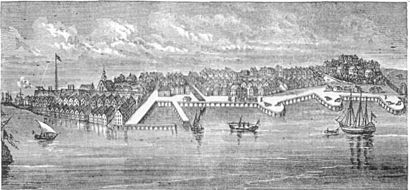New York Slave Revolt of 1712 facts for kids
The New York Slave Revolt of 1712 was an uprising by enslaved people in New York City. On April 6, 1712, about 23 enslaved Black people rebelled. They attacked white colonists, killing nine and injuring six others. After the revolt, more than 70 Black people were arrested. Of these, 27 faced trial, and 21 were found guilty and executed.
Contents
Life for Enslaved People in New York
By the early 1700s, New York City had a large number of enslaved people. About 20 percent of the city's population were enslaved Black people. Unlike some other colonies, New York did not have large farms called plantations. Instead, enslaved people worked in many different jobs.
They worked as house servants, skilled craftspeople, and dock workers. Enslaved Africans often lived close to each other in the city. This made it easier for them to talk and plan together. They also sometimes worked alongside free Black people. This was different from plantations in the South.
Changes in Rights and Laws
After the English took over New Netherland in 1667, the rights of free Black people slowly disappeared. In 1702, the first New York slave codes were passed. These laws further limited the rights of the African community. Many rights, like owning land and getting married, had been allowed when the Dutch ruled.
On December 13, 1711, New York City opened its first slave market. This market was near Wall Street. It was used to sell and rent enslaved Africans and Native Americans. The colonial government also made other rules. Enslaved people needed a pass to travel far from home. They could not gather in groups of more than three people. They also had to sit in separate areas during church services.
The Uprising of 1712
On the night of April 6, 1712, a group of more than twenty enslaved Black people met. They set fire to a building on Maiden Lane. This street was near Broadway. When white colonists came to put out the fire, the enslaved people attacked them. They used guns, hatchets, and swords.
After the attack, the rebels tried to escape. However, colonial forces quickly captured them. All of the enslaved people who ran away were caught. They were then returned to their owners.
What Happened Next
After the revolt, colonial forces arrested 70 Black people. They were put in jail. Six of them reportedly died while in jail. Twenty-seven people faced trial. Out of these, 21 were found guilty and sentenced to death. This included one woman who was pregnant.
The city and colony then passed even stricter laws. These new laws controlled Black and Indian enslaved people more tightly. Enslaved people could not gather in groups larger than three. They were not allowed to carry firearms. Gambling was also made illegal. Crimes like damaging property or planning to kill someone could lead to the death penalty.
However, free Black people were still allowed to own land. For example, Anthony Portuguese owned land that is now part of Washington Square Park. His daughter and grandchildren continued to own this land.
The colony also made it very hard for slave owners to free their slaves. Owners had to pay a tax of £200 for each person they wanted to free. This amount was much higher than the cost of an enslaved person. In 1715, Governor Robert Hunter spoke in London. He argued that allowing slaves to be freed was important for New York. He believed it was a fair reward for enslaved people who helped their masters earn money. He also thought it could prevent enslaved people from losing all hope.
See also
 In Spanish: Revuelta de esclavos de Nueva York de 1712 para niños
In Spanish: Revuelta de esclavos de Nueva York de 1712 para niños


